Directing Chapter Notes | Business Studies (BST) Class 12 - Commerce PDF Download
| Table of contents |

|
| Introduction |

|
| What is Directing? |

|
| Supervision |

|
| What is Motivation? |

|
| Leadership |

|
| Communication |

|
Introduction
Directing is a vital function of management that turns plans into action. It involves guiding, supervising, motivating, and leading employees to achieve organisational goals. More than just giving instructions, directing ensures that individuals work together efficiently and stay aligned with the organisation’s vision. Like a teacher who not only gives homework but also inspires students to learn, a manager uses direction to bring out the best in their team. Let's learn more about this management function. 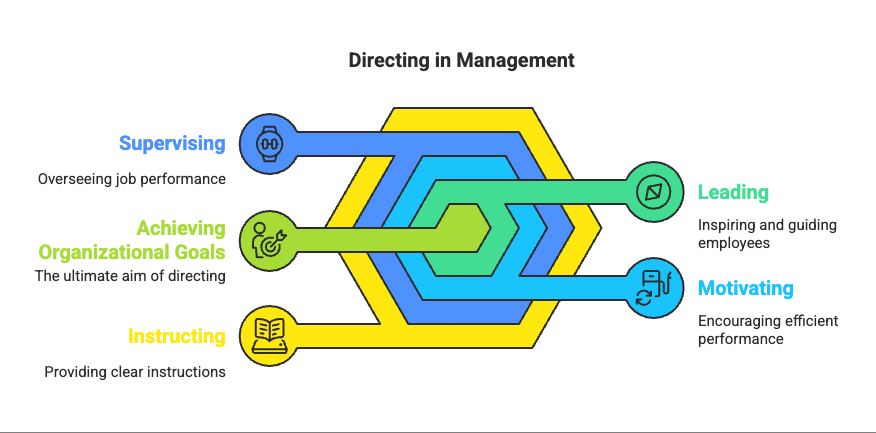
What is Directing?
Directing as a function of management, refers to the process of instructing, guiding, counselling, motivating and leading people in the organization to achieve its objectives.
- It does not mean only instructions but also includes supervising the employees when they are performing the job, motivating them to perform more efficiently and leading them towards the achievement of organisational goals.
Characteristics of Directing
- Initiates Action: Directing is essential for starting action within an organisation. While planning, organising, staffing, and controlling set the stage, directing is what triggers action.
- Present at Every Level: Every manager, from top executives to supervisors, is involved in directing. It occurs wherever there are superior-subordinate relationships.
- Continuous Process: Directing is an ongoing activity that happens throughout the life of the organisation, regardless of who holds managerial positions. Examples like Infosys and Tata show that directing continues even with changing managers.
- Flows from Top to Bottom: Directing starts at the top level and flows down through the organisational hierarchy. This means that every manager can direct their immediate subordinates while receiving instructions from their superiors.
Importance of Directing
1. Initiates Action
- Directing is responsible for initiating action by individuals in the organisation towards achieving the desired objectives.
- For example, when a supervisor guides and clarifies doubts for subordinates, it helps them meet work targets effectively.
2. Integrates Employee Efforts
- Directing ensures that individual efforts are aligned with organisational goals.
- A manager with strong leadership skills can convince employees that their individual and team efforts contribute to the overall success of the organisation.
3. Realises Employee Potential
- Effective directing involves motivating and providing leadership to help employees realise their full potential.
- A good leader can identify the capabilities of employees and inspire them to perform at their best.
4. Facilitates Change
- Directing plays a crucial role in introducing necessary changes within the organisation.
- People often resist change, but effective directing through motivation, communication, and leadership can reduce this resistance.
- For instance, when a manager wants to implement a new accounting system, explaining the purpose, providing training, and offering incentives can help employees accept the change.
5. Brings Stability and Balance
- Effective directing fosters cooperation and commitment among employees, leading to stability and balance within the organisation.
- It helps achieve harmony among different groups, activities, and departments, contributing to the overall effectiveness of the organisation.
Additional Aspects of Directing
- Directing occurs at all management levels: Every manager, from top executives to supervisors, engages in directing.
- Directing is an ongoing process: It is a continuous function that persists throughout the life of the organisation, regardless of who holds managerial roles.
- Directing flows from top to bottom: It starts at the top level and moves down through the organisational hierarchy.
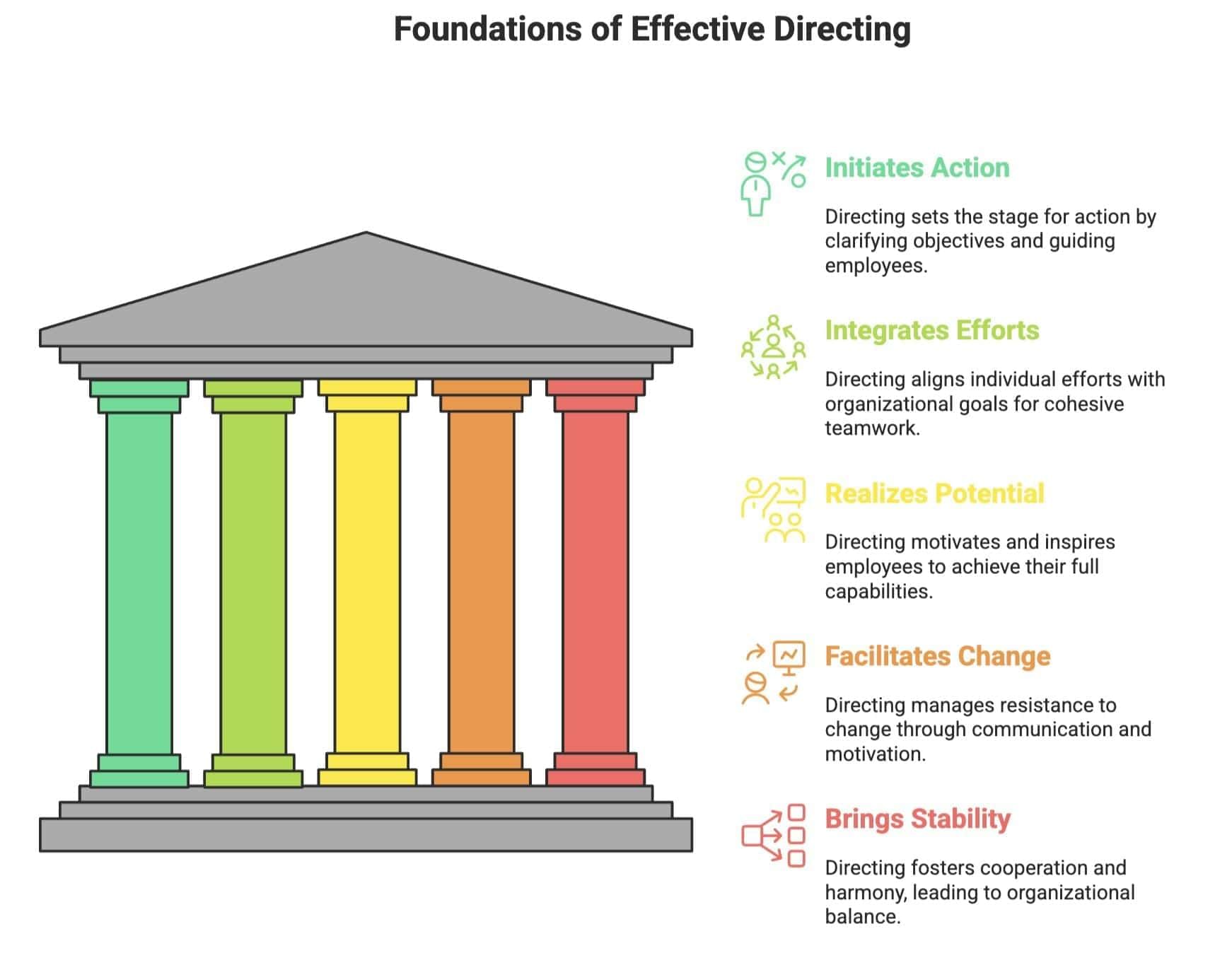
Principles of Directing
Providing good and effective direction is a challenging task as it involves many complexities. A manager has to deal with people with diverse backgrounds and expectations. This complicates the directing process. Certain guiding principles of directing may help in the directing process.
1. Maximum Individual Contribution:
- Directing techniques should enable every individual in the organisation to contribute their maximum potential towards achieving organisational objectives.
- It aims to tap into the untapped energies of employees to enhance organisational efficiency.
- For instance, a well-designed motivation plan with appropriate monetary and non-monetary rewards can inspire an employee to give their best efforts, knowing that their contributions will be duly rewarded.
2. Harmony of Objectives:
- Directing should foster alignment between the personal goals of employees and those of the organisation.
- Sometimes, these goals may appear to be at odds, such as when an employee desires a higher salary while the organisation seeks to enhance productivity.
- Effective directing aligns the efforts of employees so that each person's contribution positively impacts the organisation's performance.
3. Unity of Command:
- This principle states that each individual in the organisation should receive orders from only one superior.
- Receiving directions from multiple superiors can cause confusion, conflict, and chaos.
- Following this principle ensures clear and effective guidance, reducing uncertainty for subordinates.
4. Appropriateness of Direction Technique:
- Directing techniques should be tailored to the needs, capabilities, attitudes, and situational variables of subordinates.
- For example, while some individuals may be motivated by monetary incentives, others may respond better to promotion opportunities.
- Using appropriate motivational and leadership techniques enhances the effectiveness of directing.
5. Managerial Communication:
- Clear communication at all levels of the organisation is crucial for successful directing.
- Directing should convey straightforward instructions to ensure total understanding among subordinates.
- Providing clear instructions and feedback is essential to help subordinates grasp their responsibilities.
- Managers should encourage feedback to verify that instructions are comprehended, promoting better communication and understanding.
6. Use of Informal Organisation:
- Managers should recognise and leverage informal groups or organisations that naturally exist within formal structures.
- Identifying and utilising these informal networks can enhance the effectiveness of directing by tapping into existing social dynamics and relationships.
7. Leadership:
- Effective leadership is crucial while directing subordinates, as it positively influences their behaviour and motivation.
- Good leadership involves guiding and inspiring employees without causing dissatisfaction and fostering a positive work environment.
8. Follow Through:
- Simply giving an order is not sufficient; managers should continuously monitor and review the implementation of directives.
- Regular follow-up ensures that orders are being carried out as intended and helps identify any issues or challenges.
- If necessary, managers should make suitable modifications to directions based on feedback and observations.
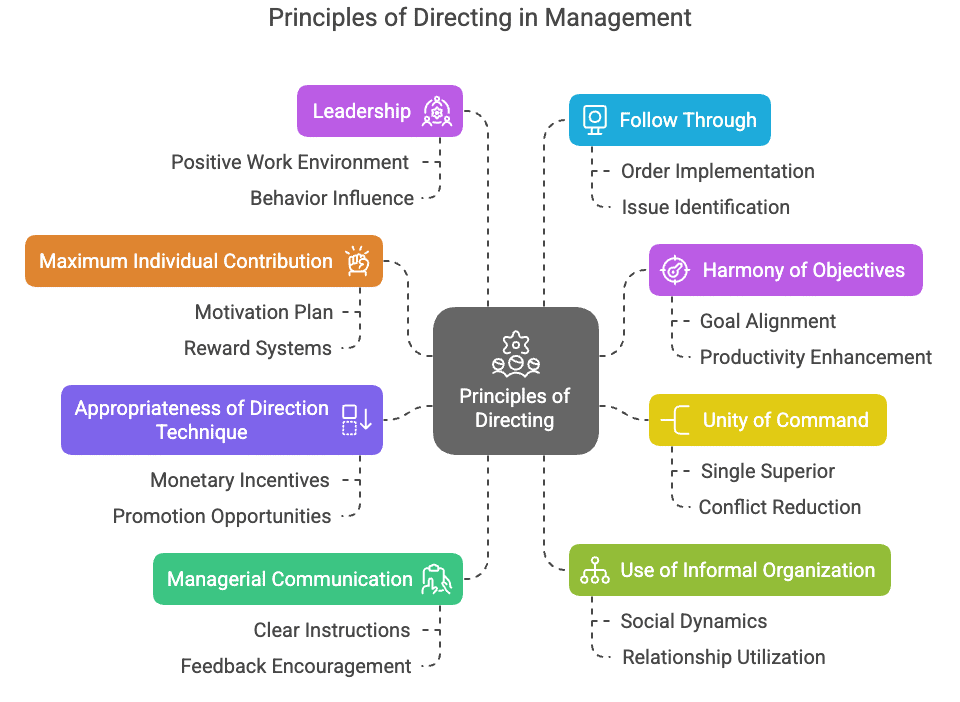
Elements of Directing
1. Supervision:
- Supervision involves overseeing the work of employees to ensure that they are performing their tasks correctly and efficiently.
- Supervisors play a vital role in providing guidance, feedback, and support to workers on the shop floor.
- Effective supervision helps maintain quality standards and keeps the workflow smooth.
2. Motivation:
- Motivation is about inspiring and encouraging employees to put in their best effort.
- Managers can motivate their teams through various means, such as offering incentives, recognising achievements, and creating a positive work environment.
- A motivated workforce is more productive and committed to the organisation's goals.
3. Leadership:
- Leadership involves guiding and influencing employees towards achieving organisational objectives.
- A good leader sets a vision, leads by example, and fosters a collaborative and supportive atmosphere.
- Leadership is not just about giving orders; it's about inspiring trust and respect among team members.
4. Communication:
- Communication is the backbone of effective directing.
- Managers need to communicate clearly and openly with their teams to ensure everyone is on the same page.
- This includes sharing information, providing feedback, and encouraging open dialogue.
- Good communication helps prevent misunderstandings and keeps the team aligned with organisational goals.
Let's learn about these elements in detail.
Supervision
Supervision can be understood in two ways:
As part of directing: Every manager supervises their team by guiding employees' efforts and overseeing tasks to ensure resources are used efficiently and goals are achieved.
As a specific role: A supervisor holds a position just above the workers, directly managing their activities. This role is crucial since supervisors have close interaction with workers, unlike higher-level managers.
Importance of Supervision
The role of a supervisor is as follows:
1. Link between workers and management because the supervisor explains management policies to workers and brings workers' problems to the notice of the management.
2. Ensures performance of work according to the targets set: The supervisor is responsible for achieving tasks and effectively motivating workers.
3. Facilities Control: Control means a match between actual and planned output. It ensures checking on the methods in use and the progress of work according to the planned schedule.
4. Maintenance of discipline: The strict supervision and guidance of the supervisor encourage the employees and workers to be more disciplined in their activities. Under the guidance of superiors, the workers follow a fixed or strict timetable and execute the plans in the right direction.
5. Feedback: The supervisors are directly dealing with the subordinates. As a result, feedback in the form of suggestions and grievances keeps coming to the management. It improves quality management decisions and revision of plans & policies.

6. Improved Motivation: A supervisor with good leadership qualities can build up high morale among workers. The relationship with the supervisor is a very good incentive to improve the motivation level of the employees. While guiding the employees, the supervisors encourage the subordinates to perform to their best capacities.
7. Optimum utilisation of resources: All the activities are under the observation of the supervisor, so less wastage and optimum utilisation of resources is possible.
8. Maintenance of group unity: The supervisor plays a vital role in promoting group cohesion among workers under their supervision.
9. On-the-job training: The supervisor provides on-the-job training to workers, which is essential for improving their skills and efficiency.
What is Motivation?
- It is the process of encouraging people to perform at their best to achieve desired goals.
- Motivation refers to the act of inspiring or prompting action. In a workplace, it involves guiding employees to behave in a way that meets specific organisational objectives.
- It includes activating needs and wants in individuals to start and direct their actions towards a purposeful outcome.
- Motivation is linked to fulfilling people’s needs.
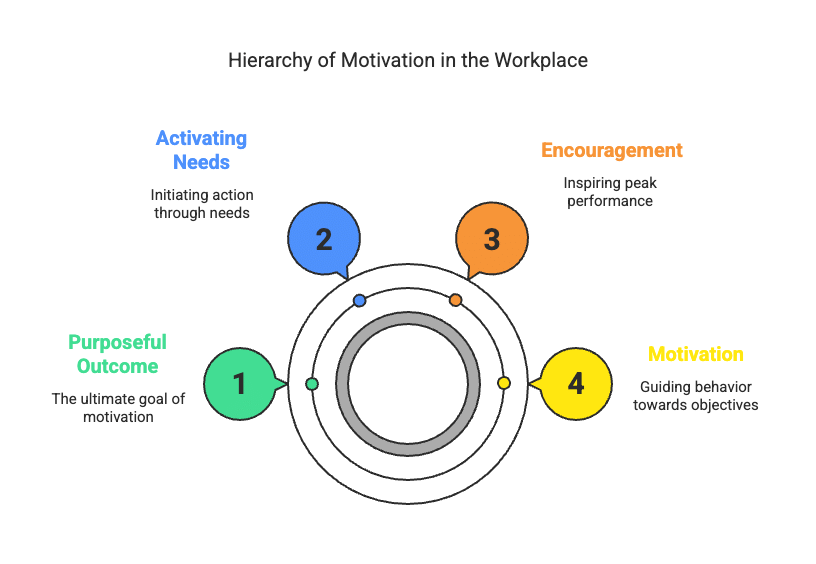
When discussing motivation, it is important to understand three connected terms:
- Motive: Motive is an internal condition that energises and directs behaviour towards goals. Motives stem from individual needs. The fulfilment of a motive creates restlessness, leading to actions aimed at alleviating that unrest.
- Motivation: Motivation is the process that inspires individuals to take action to reach their desired goals.
- Motivators: Managers employ various motivators such as salary, bonuses, promotions, recognition, praise, and responsibility to encourage people to give their best effort.
Motivation can be categorised as either positive or negative.
According to William G. Scout, "Motivation means a process of stimulating people to action to accomplish desired goals."
Features of Motivation
1. Psychological Phenomenon
Motivation is an internal feeling that drives human behaviour based on urges, desires, and needs. For instance, someone may feel the desire to own a motorbike, live in a comfortable house, or gain social recognition. These urges come from within the individual.
2. Goal-Directed Behaviour
It encourages individuals to act in ways that help them reach their goals. A motivated person strives to achieve their desired outcomes. For example, an employee may work harder to earn a promotion, which in turn enhances their performance.
3. Motivation can be either positive or negative
Positive motivation involves encouraging people to improve their work and recognising their efforts, such as through pay raises or promotions. Negative motivation, however, involves compelling individuals to work through threats or punishments, like demotion or withholding pay increases.
4. Complex Process
Motivation is intricate because individuals have different expectations, perceptions, and reactions. Therefore, the same type of motivation may not affect everyone in the same way.
5. Continuous Process
Human needs are never-ending and continually evolve. When one need is met, another emerges. This means managers must always motivate their teams. Effective motivation allows managers to implement changes smoothly with minimal resistance.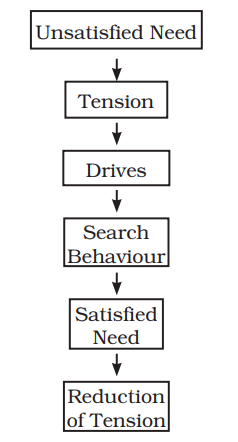
Importance of Motivation
Motivation plays a key role in improving employee performance and organisational success. Here are its key benefits:- Improves Performance: When employees' needs are fulfilled, they give their best effort, resulting in increased productivity for both the employees and the organisation. Motivation helps to recognise and meet the needs of staff, thereby boosting their performance.
- Changes Attitude: Motivation can transform negative or indifferent attitudes of employees into positive ones, aiding in the achievement of organisational goals. Adequate rewards and recognition can inspire employees to perform better.
- Reduces Turnover: Motivated employees are less likely to leave, which decreases the costs and efforts involved in hiring and training new staff. It also helps retain talented individuals, thereby saving such expenses.
- Lowers Absenteeism: When motivation is sufficient, work becomes enjoyable, leading to regular attendance. Issues like poor working conditions or lack of recognition can be addressed with effective motivational strategies.
- Eases Change Management: Motivation assists managers in implementing changes smoothly with minimal resistance. Employees are more receptive to change when they see potential benefits, such as additional rewards.
Maslow’s Need Hierarchy Theory of Motivation
Maslow’s Theory focuses on needs as the basis for motivation. It classified human needs into the following five categories. It helps managers to realise that the need level of employees should be identified to motivate them. It is based on the following assumptions:
(i) People’s behaviour is based on their needs.
(ii) People’s needs are in hierarchical order.
(iii) A satisfied need can no longer motivate a person.
(iv) A person moves to the next higher level of hierarchy only when the lower need is satisfied.

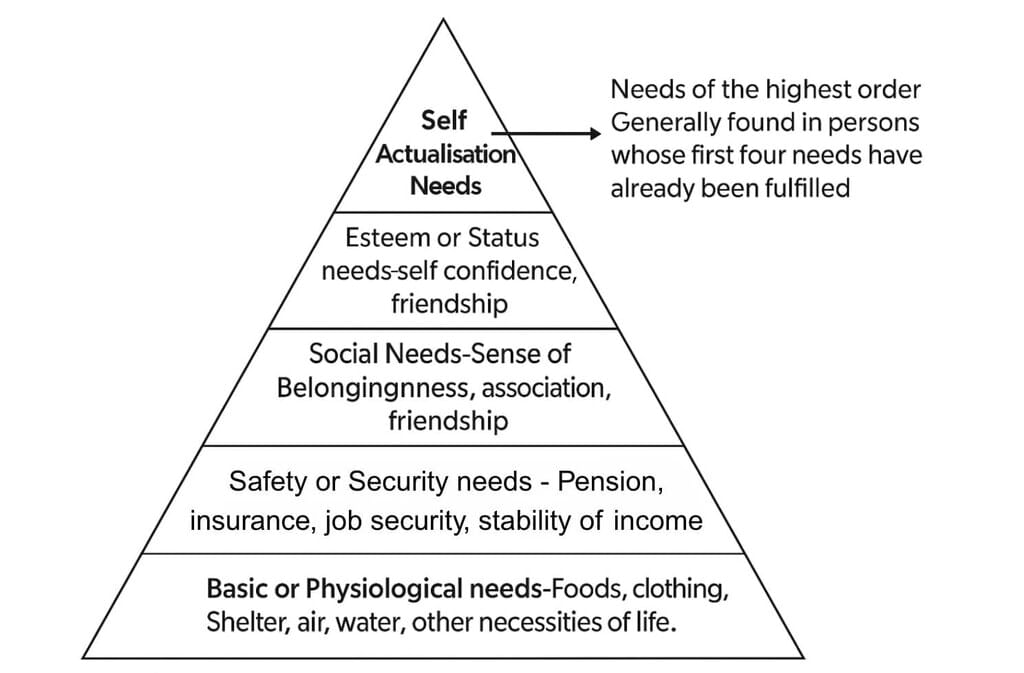
Financial and Non-Financial Incentives
An incentive refers to any measure taken to encourage individuals to enhance their performance. These can be divided into two main categories: financial and non-financial.
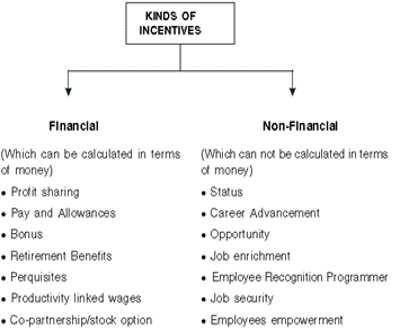
Financial Incentives
In the current economic system, these refer to monetary rewards beyond the regular salary. They include:
- Pay and Allowances: Salary is the basic incentive, including pay, allowances, and regular increments.
- Productivity-Linked Wages: Wages tied to individual or group productivity levels.
- Bonus: Extra pay given beyond regular wages or salary.
- Profit Sharing: Employees receive a share of company profits, encouraging better performance.
- Stock Options: Employees get company shares at lower prices, fostering a sense of ownership.
- Retirement Benefits: Provident funds, pensions, and gratuities offer post-retirement security.
- Perquisites: Extra benefits like company cars, housing, or medical aid are provided in addition to salary.
Non-Financial Incentives
- Status: Refers to the ranking of positions within the organisation.
- Organisational Climate:. A positive work environment with autonomy and rewards enhances employee satisfaction.
- Career Advancement: Opportunities for skill development and promotions encourage improved performance.
- Job Enrichment: Adding variety and responsibility to roles makes work more engaging.
- Employee Recognition: Acknowledging good performance through awards or public praise increases motivation.
- Job Security: Stable employment reduces anxiety and promotes better focus and productivity.
- Employee Participation: Involving staff in decision-making boosts engagement.
- Employee Empowerment: Granting autonomy to employees makes them feel valued, enhancing job performance.
Leadership
- Leadership is the activity of influencing people to strive willingly for mutual objectives.
- Managers at all levels are expected to be the leaders of their subordinates.
- Leadership indicates the ability of an individual to maintain good interpersonal relations with followers and motivate them to contribute to achieving organisational objectives.
- As noted by the well-known management consultant Stephen Covey, while managers are significant, leaders are essential for achieving long-lasting success.
- It is a process of interaction between the leader and his followers.
- It helps in persuading employees to work cooperatively and enthusiastically towards common goals.
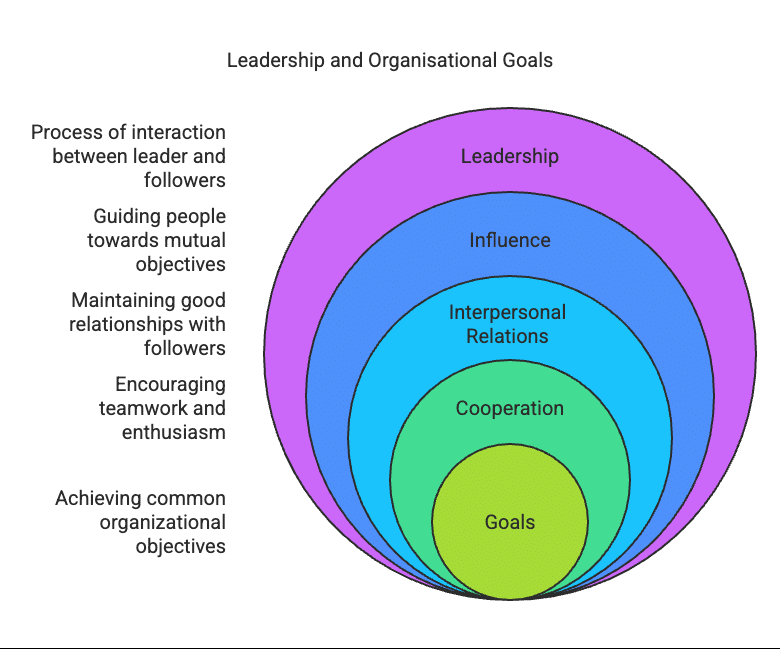
Importance of Leadership
- Influences Positive Behaviour: A strong leader encourages individuals to focus their efforts on the organisation's success.
- Builds Strong Relationships: Leaders uplift their followers, enhancing their confidence and fostering a supportive work atmosphere.
- Facilitates Change: A leader is vital in implementing necessary changes within the organisation, inspiring people to embrace these changes wholeheartedly.
- Manages Conflicts: A good leader allows followers to express their feelings and disagreements while guiding them with appropriate clarifications.
- Prepares Future Leaders: Leaders nurture and develop their teams, ensuring a seamless transition for future leaders.
Leadership is an ongoing process that reflects an individual's capability to maintain positive relationships with followers and motivate them to work towards achieving organisational goals.
Effective leadership is about completing tasks on time and achieving goals while minimising costs. A leader not only engages their followers with the organisation’s aims but also gathers essential resources and motivates subordinates to accomplish these targets.
It’s important to note that not all effective leaders possess every quality of a good leader. In fact, it is unrealistic for any one person to embody all these traits. However, understanding these qualities can help managers develop them through training and intentional efforts.
Styles of Leadership
- Leadership styles refer to a leader’s behaviour.
- The behavioural pattern that the leader reflects in his role as a leader is often described as the style of leadership.
- A Leadership style is the result of the leader’s philosophy, personality, experience and value system.
- It also depends upon the type of followers and the atmosphere revealed in the organization.
Different types of leadership styles are:
1. Autocratic leadership
2. Participative leadership/Democratic
3. Free rein leadership/Laissez Faire
A leader may use all styles over time, but one style tends to predominate as their normal way of using power.
Autocratic or Authoritarian Leader
- An autocratic leader gives orders and insists that they be obeyed.
- He determines the policies for the group without consulting them.
- He does not give information about future plans but simply tells the group what immediate steps they must take.
- Under this style, all decision-making power is centralised in the leader.
- He does not give his subordinates any freedom to influence his decisions.
- It is like “bossing people around.”
- This style should normally be used on rare occasions.
- It is best applied to situations where there is little time for group decision-making or where the leader is the most knowledgeable member of the group.

Democratic or Participative Leader
- A democratic leader gives orders only after consulting the group and works out the policies with the acceptance of the group.
- He never asks people to do things without working out the long-term plans on which they are working.
- He favours decision-making by the group as shown in the diagram.
- This improves the attitude of the employees towards their jobs and the organization, thereby increasing their morale.
- Using this style is of mutual benefit - it allows them (subordinates) to become part of the team and helps leaders (seniors) to make better decisions.
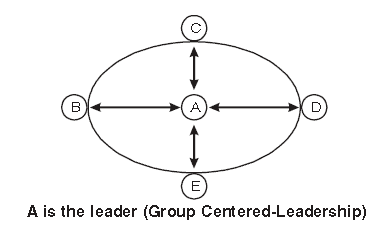
When should participative/democratic leadership be applied?
- It is most effective when group members are skilled and keen to share their knowledge.
- Having ample time is essential for people to contribute, develop a plan, and vote on the best actions.
- This style should NOT be used when: Roles are unclear or time is critical; democratic leadership may cause communication failures and incomplete projects.
Laissez Faire or Free Rein Leader
- A free-rein leader gives complete freedom to the subordinates.
- Such a leader avoids the use of power.
- He depends largely upon the group to establish its own goals and work out its own problems.
- Group members work themselves as per their own choice and competence.
- The leader exists as a contact man with the outsiders to bring information and the resources that the group requires to accomplish the job.
- Note: This is also known as laissez-faire which means no interference in the affairs of others (French word laissez means to let/allow and faire means to do).
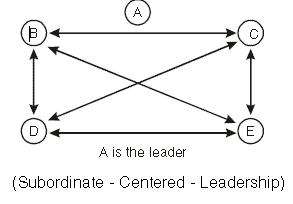
When should laissez-faire/free-rein leadership be applied?
- This style works well when followers are highly skilled, experienced, and educated.
- Followers take pride in their work and are driven to succeed independently.
- It is useful when involving outside experts, like staff specialists or consultants.
- Followers need to be trustworthy and experienced.
This style should NOT be used when:
Followers feel insecure about the non-availability of a leader. The leader cannot or will not provide regular feedback to his followers.
Communication
- Communication encompasses everything a person does to foster understanding in another's mind. It is a continuous process involving telling, listening, and comprehension.
- It is a fundamental part of managerial activities.
- A manager's ability to direct largely relies on their communication skills.
- This is why the organisation places importance on enhancing the communication skills of both managers and employees.
- Effective communication is crucial for the swift and successful execution of managerial tasks.
- Successful communication lays the groundwork for coordination, decision-making and boosts managerial effectiveness.
- Challenges to effective communication include inattentive listeners, incorrect interpretation, and biases that hinder message comprehension.
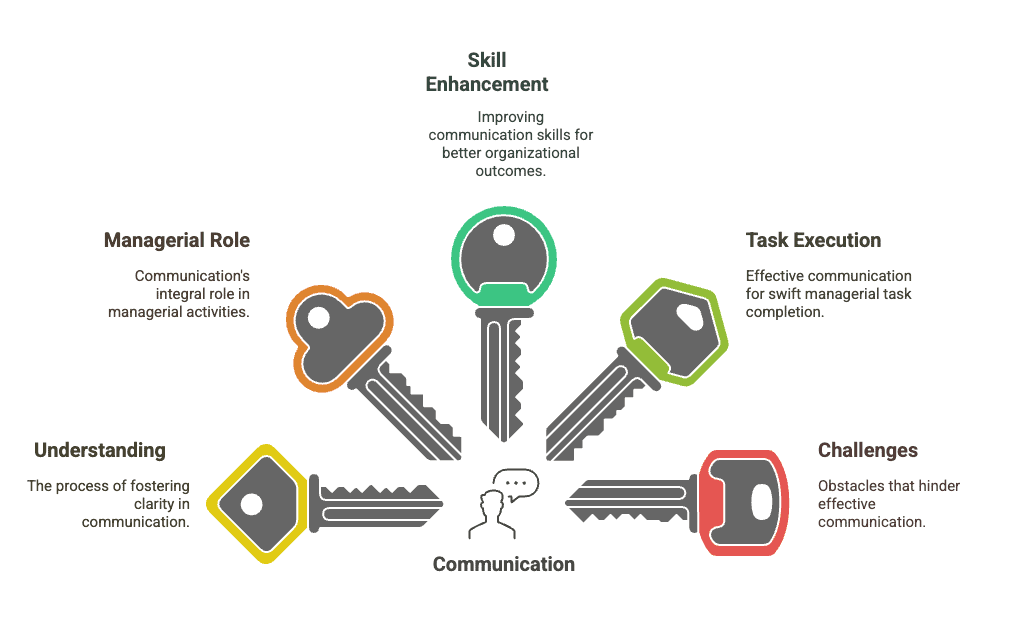
Elements of the Communication Process
- Sender: The sender is the person who shares thoughts or ideas with the receiver, acting as the source of communication.
- Message: This refers to the content that includes ideas, feelings, suggestions, orders, etc., intended for communication.
- Encoding: This is the process of transforming the message into symbols for communication, such as words, pictures, or gestures.
- Media: Media is the channel through which the encoded message is sent to the receiver, which can be written, face-to-face, via phone calls, or the Internet.
- Decoding: This is the process where the receiver interprets the encoded symbols sent by the sender.
- Receiver: The receiver is the individual who gets the message from the sender.
- Feedback: Feedback consists of the receiver's responses indicating that the message from the sender has been received and understood.
- Noise: Noise refers to any interference or barrier in communication, which can affect the sender, the message, or the receiver. Examples include:
- Ambiguous symbols leading to incorrect encoding.
- Poor telephone connections.
- An inattentive receiver.
- Incorrect decoding (misinterpreting the message).
- Prejudices hindering the understanding of the message.
- Gestures and postures that may distort the message.
Importance of Communication
- Facilitates Coordination: It helps different departments work together, creating a unified purpose and action.
- Provides Data Necessary for Decision-Making: Communication delivers essential information for making decisions. When management receives information effectively, it aids in their decision-making process.
- Increases Managerial Efficiency: Effective communication is crucial for quick and efficient managerial tasks. Management uses communication to share goals, issue instructions, assign tasks, and monitor subordinates' performance.
- Promotes Cooperation and Industrial Peace: Good management aims for efficient operations, achievable through industrial peace and cooperation between management and workers. Two-way communication fosters understanding and collaboration.
- Establishes Effective Leadership: Leadership relies on communication. It helps influence subordinates positively. A two-way flow of information between superiors and subordinates encourages a constructive response from employees.
- Boosts Morale and Provides Motivation:. strong communication system helps management motivate and satisfy employees. Good communication assists workers in adapting to their work environment and improves human relations in the industry.
In many organisations, various barriers might hinder effective communication.
Communication within an organisation can be generally classified as formal and informal.
Formal Communication
It refers to official communication that takes place following the chain of command. Classification of formal communication-
1. Vertical Communication: Flows vertically, i.e., upwards or downwards through formal channels.
- Upward Communication: This refers to communication that moves from subordinates to superiors, such as requesting leave, submitting progress reports, or asking for funding.
- Downward Communication: This indicates communication from superiors to subordinates, like notifying employees about meetings, instructing staff to complete tasks, or sharing guidelines from top management.
2. Horizontal/lateral Communication: This occurs between individuals at the same level within the organisation. For example, a production manager may discuss product design and quality with a marketing manager.

Informal Communication: Communication that takes place without following the formal lines of communication is said to be informal communication. There is no fixed direction or path for the flow of information.
Grapevine or Informal Communication Networks:
1. Single Strand: Each person communicates with the other in a sequence.
2. Gossip: Each person communicates with all on a non-selective basis. A person shares the information with many other people in his social group.
3. Probability: The individual communicates randomly with other individuals.
4. Cluster: The individual communicates with only those people whom he trusts.
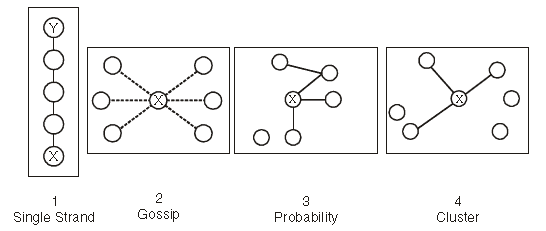
Barriers to Effective Communication
Concerned with problems and obstructions in the process of encoding or decoding the message into words or impressions.
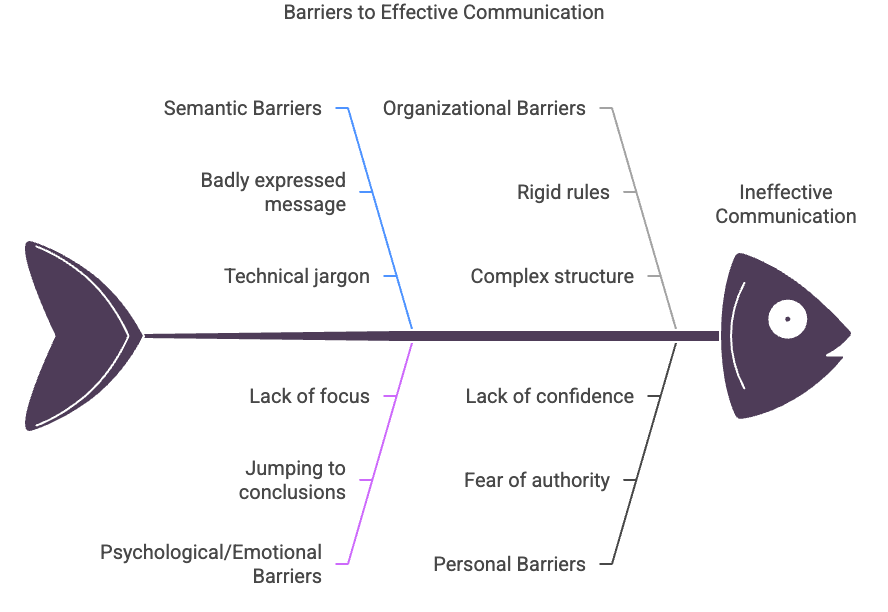
A. Semantic barriers
Semantics is a branch of linguistics that focuses on the meaning of words and sentences. Semantic barriers occur when there are issues in encoding (sending) or decoding (receiving) messages, leading to misunderstandings. Some of these barriers are:
- Badly expressed message: Sometimes intended meaning may not be conveyed.
- Choice of words: Words or symbols with different meanings confuse the receiver.
- Translation errors: Faulty translations may transfer the wrong messages.
- Unclarified assumption: Different interpretations may confuse.
- Technical Jargon: Technical words may not be understood by the workers.
- Body language and gesture decoding: If the words spoken don't align with the body movements or expressions, it can lead to misinterpretation or confusion in communication.
B. Psychological/Emotional Barriers
Feelings and mental states can hinder effective communication. For instance, a concerned sender might struggle to communicate clearly, while an upset receiver may misinterpret or overlook the message. The mindset of both the sender and receiver has a direct impact on communication effectiveness. These barriers include:
- Jumping to conclusions: Making judgments before fully listening can lead to misunderstandings.
- Lack of focus: If the receiver’s mind is preoccupied, they may not listen properly.
- Information loss: When messages are passed through several people, the original message may become distorted.
- Distrust: If parties do not trust each other, they may struggle to understand messages correctly.
C. Organisational Barriers
These arise from the structure, policies, and rules of an organisation. Key barriers include:
- Organisational Policy: If communication is restricted by policies (e.g., centralised control), it limits free flow.
- Rules and Procedures: Rigid rules can delay communication or make it complicated.
- Status Differences: Managers with high status may unintentionally discourage subordinates from speaking freely.
- Complex Structure: Many levels of management can delay and distort communication due to multiple filters.
- Lack of Facilities: Without tools like meetings, suggestion boxes, or transparent practices, communication can suffer.
D. Personal Barriers
These are individual factors that affect communication between people in an organisation:
- Fear of authority: Superiors might hold back information if they feel it threatens their position.
- Lack of confidence: Managers may be reluctant to seek input if they doubt their team's capabilities.
- Avoidance of communication: Employees might hesitate to communicate if they think it could harm their interests.
- No incentives: Without recognition or rewards, employees may be reluctant to share ideas.
Improving Communication Effectiveness
To ensure effective communication in organisations, the following strategies can be employed:
Clarify Ideas Before Communication:
- The communicator must understand the problem thoroughly before sharing it.
- A well-analysed and clear message ensures better understanding by subordinates.
Communicate According to Receiver’s Needs:
- Adjust the message to match the education and comprehension level of the audience.
- This ensures the receiver can understand and respond appropriately.
Consult Others Before Communicating:
- Involving subordinates in planning communication fosters participation and cooperation.
- This can lead to smoother implementation and acceptance of the message.
Use Appropriate Language, Tone, and Content:
- Choose words carefully to avoid misunderstandings or offending listeners.
- Ensure the message stimulates interest and encourages a response.
Share Information of Value to the Listener:
- Align messages with the interests and needs of the audience to enhance engagement.
- Relevant information encourages a positive response from the receiver.
Ensure Proper Feedback:
- Ask questions to confirm understanding and encourage two-way communication.
- Feedback helps refine future communication and ensures clarity.
Communicate for Both Present and Future:
- Communication should address current needs and align with future organisational goals.
- This ensures continuity and consistency in decision-making.
Follow-Up on Communication:
- Regularly review and monitor the implementation of instructions.
- Follow-ups help address issues promptly and ensure tasks are completed effectively.
Be a Good Listener:
- Active listening fosters trust and shows subordinates that their input is valued.
- Patient listening helps resolve issues and strengthens communication.
By adopting these measures, organisations can enhance the effectiveness of communication and create a more collaborative and responsive work environment.
|
51 videos|230 docs|49 tests
|
FAQs on Directing Chapter Notes - Business Studies (BST) Class 12 - Commerce
| 1. What is the role of directing in management? |  |
| 2. How does supervision differ from directing? |  |
| 3. What are effective methods of motivation in the workplace? |  |
| 4. What qualities make a good leader in a directing role? |  |
| 5. Why is communication important in the directing process? |  |
















